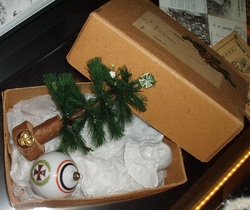 Christmas box sent to WW1 German troops
Christmas box sent to WW1 German troops As I understand the Battle of the Marne, the larger force of the French army was assisted by the remnant of the British Expeditionary Force in preventing the oncoming German army from taking Paris. The BEF had been reduced to two-thirds of its strength after Mons, and General French had intended to return with them to England, but was ordered by Kitchener to go to the aid of their French allies.
Our first stop was a visit to the wonderful Musee de la Grande Guerre, in Meaux. This stunning collection of artefacts and original vehicles is based on over 55,000 items amassed by a local collector. The museum has worked hard to give a context to its displays, but to keep it accessible – they have clearly given a lot of thought to the exhibitions. For example, the mannequins have been modelled in white and stylised, to signify that this is not an attempt to make them wholly realistic, since nothing can truly convey the horror of the soldiers’ experience. Visiting children are also encouraged to touch the exhibits, and there is a marked route for primary school children which features the role played by animals in the war. As well as some excellently restored large vehicles and reproduction trench sections, there are a number of themed rooms in the museum: displays of uniforms, colonial troops, daily life of soldiers, armaments etc.
Highlights for me included: the original double-decker carrier-pigeon transport and 1908 Bleriot airplane, the stereoscopic slide show (3D glasses provided) of photos on various themes eg gas, the Battle of the Marne; the Body & Suffering room, a smaller, more intimate and darkened space, with deeply moving films of shell-shocked patients, pictures of “les gueules cassees (broken faces)”, amputees etc
the trench-art, including musical instruments made from tin hats, Christmas boxes sent to German troops (not much German metal trench-art – this had to be sent home, desperately needed because of the blockade on imports by the allied navies); early attempts at metal body-armour, rejected because too heavy, looking more Roman/medieval than modern; flechettes, the first airborne weapon, little metal arrows dropped by hand from the early lightweight airplanes.
Among our party was a French writer and military historian. I asked him if he could recommend a French book portraying the First World War. I had long intended to read Henri Barbusse’s Le Feu, but Francois suggested instead Maurice Genevoix’s Ceux de 14, and Jean Norton Cru’s Temoins, which analyses the collective oeuvre of memoirs by French authors.
We drove on through the beginnings of champagne-growing country, and stopped in Le Petit Morin valley, where nearly 20,000 British troops crossed. The German troops here were aiming to delay their advance, and they captured thousands of exhausted, starving soldiers who, after the retreat from Mons, blowing up bridges as they went, having scant time to stop, rest, and eat, simply fell asleep so deeply they could not be woken by their companions.
We stopped at La Ferte sous Jouarre to see the British Memorial to the Missing there, which commemorates nearly 4,000 officers and men of the British Expeditionary Force who died in August, September and the early part of October 1914 and who have no known grave.
We wondered why it was that those lost on the Marne are not as significant a part of the Great War memory in Britain, and whether it was perhaps that they were part of the professional army and reserves, not the ‘butchers, bakers and candlestick-makers’ who came after? Charles Pankhurst had enlisted in 1906, had served in India for six years, and had the honour of being the gymnastic leader of the Battalion. Stephen Funnell’s parents, who lost their son when he was only 20, had his name inscribed on their own gravestone in Southborough Cemetery.
If you are visiting Paris, or taking the family to Eurodisney, you may find it worthwhile to include a day visiting the Marne battlefield and Great War Museum.
Musee de la Grande Guerre, Meaux
http://www.museedelagrandeguerre.eu/en
The Doings of the Fifth Brigade by Edward, Lord Gleichen – e-book available free online thanks to Project Guttenberg:
http://www.gutenberg.org/files/22074/22074-h/22074-h.htm
Frank Baldwin, Battlefield Guide
http://www.frankbaldwin.co.uk
Nothing in this World by Charles Peguy

 RSS Feed
RSS Feed
